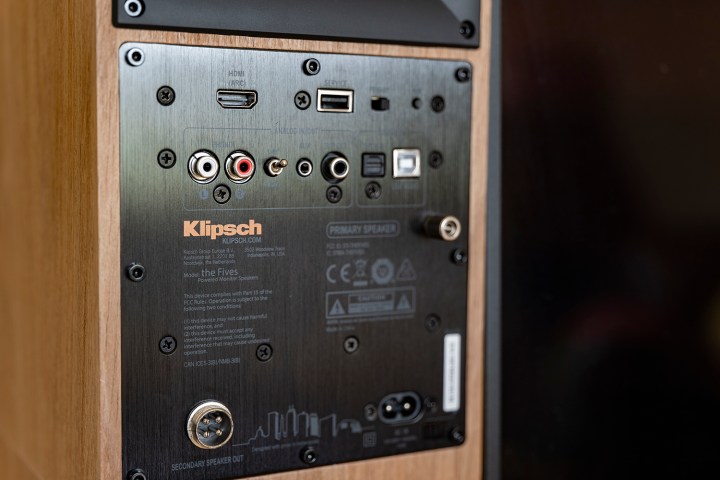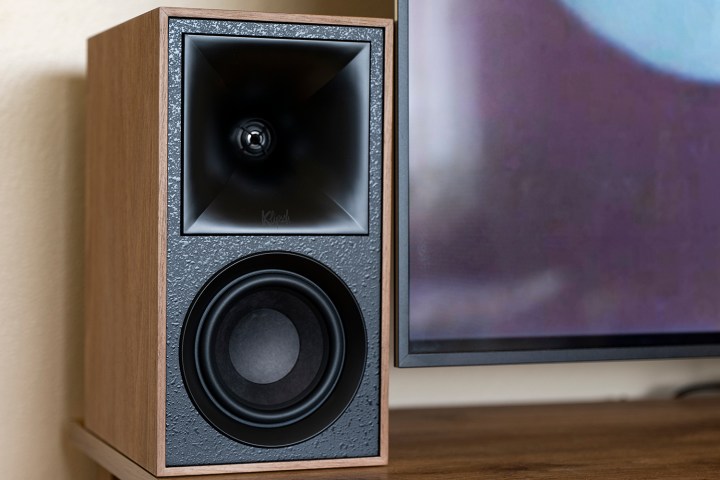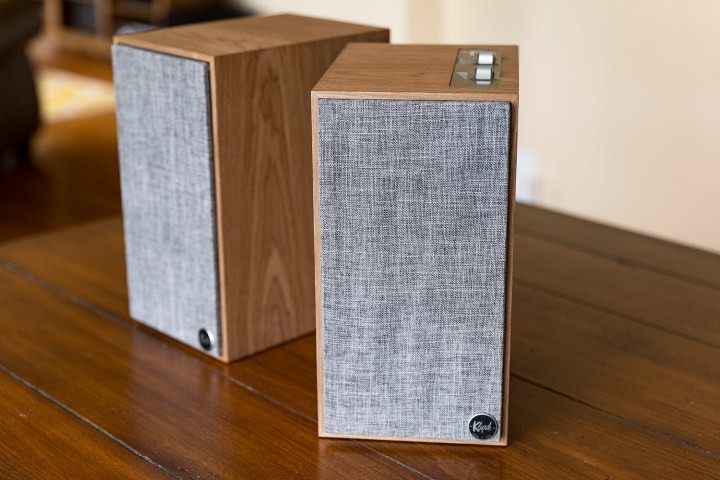“The Fives prove true left and right channels beat the pants off most soundbars, and look great doing it.”
- Powerful, balanced, true stereo sound
- Excellent multimedia audio experience
- Stellar phantom center channel
- Beautiful design
- Multiple connection options
- May not fit in every home theater setup
The soundbar was born as an easy plug-and-play solution to offer good audio quality in a simple device that didn’t ask you to pick up a degree in audio design from the local community college. Soundbars have since come to dominate home theater audio, displacing speakers in most homes.
But Klipsch disagrees that the soundbar is the best and only option here. It believes a soundbar can’t provide quality stereo sound because it’s limited by being a single center-positioned speaker. So rather than make what was popular, Klipsch decided to create The Fives, a $799 answer to the soundbar craze.
Do they successfully clap back? Let’s dig into it.

Stylish and attractive
Soundbars have a consistent issue. They’re not the most attractive devices. With rare exceptions like the Bose Soundbar 700, they are generally hulking blocks of black plastic. Even in the case of the Bose which manages to look pretty good, soundbars rarely work alongside living room décor. Black is not the dominant color of my particular home setup, and can clash with the white and wood accents in my living room.

While you can get The Fives in black, I was elated to see that walnut is also a color option. It just so happens that my media stand has a walnut veneer, and The Fives look outstanding on it. They blend in so well that unless you’re trying to notice the speakers, they disappear into my media setup.
Overall, The Fives kill it with their aesthetic.
Most powered bookshelf-style speakers require the unit with all the controls and cable inputs be a specific speaker, either the left or the right speaker (in my experience, it tends to be the right speaker). While I have them set up with the main speaker as the right speaker, The Fives have a switch on the back of the main speaker that allows you to toggle between left and right. Where the main controls and cables go is completely up to you and your setup.

On the top of the main speaker are two dials, one for controlling volume in an old-school tactile way (should you choose), the other to toggle among connection options. Neither of these dials is a requirement to use, as all those features can be accessed via the infrared remote. Still, it’s nice to have them as an option, and they feel nice to use. They have a wide design, toothed grip, and lightly notched feel that makes them remarkably satisfying.
Overall, The Fives kill it with their aesthetic. In my opinion, they look better than any soundbar I’ve encountered.
The Fives: Connected
The Fives offer the ease of connectivity with your television by being the first stereo bookshelf speakers to offer HDMI ARC compatibility, and setting them up is just as easy as plugging in a soundbar.

In addition to HDMI ARC, The Fives also support optical, Bluetooth, phono, USB, and aux via mini-jack. There is also an output jack for an optional subwoofer. You can connect your more audio-specific device, like a turntable, thanks to the array of choices, and switching among them is easy via the aforementioned dial, or using the remote.
It’s clear that Klipsch is an audio company used to catering to the needs of music fans, and that lineage definitely comes through with the connection options.
Two is better than one
Soundbars do a reasonable job with stereo sound, but even if they have the left and right surround speakers that some sets come with, your primary audio will be coming from one center-weighted source. Single-soundbar solutions like the Bose Soundbar 700 and Sonos Arc do their best to trick your ears into thinking there is a wide distance between the soundbar drivers when there isn’t. However digital trickery can only go so far.

Klipsch intends The Fives as a soundbar alternative for folks who enjoy the easy plug-and-play nature of soundbars, but crave better stereo sound. Because The Fives divide their left and right channels into physically separate speakers, you have complete freedom to spread The Fives to the sides of your television regardless of its size, and enjoy the benefits of that true separation.
Where soundbars try and recreate the sound of the left and right, The Fives have to recreate the sound of a middle. This “phantom center channel” is rendered exceedingly well in my testing. Placed on either side of my 65-inch Sony television, I felt blanketed in sound. Despite there being no actual center channel, my ears believe they hear audio coming directly at me, as if from the middle of my television.
The Fives do something very few soundbars successfully accomplish — deliver fantastic home theater sound.
The result is an audio experience that renders great studio sound without sacrifice. The Fives deliver fantastic home theater sound, engaging and immersive video game audio, and outstanding music. If you use your home entertainment center as a true multimedia hub, The Fives can stand up to that kind of demand.
Avengers: Endgame felt like a theatrical experience, with the rumbles of Thanos’ army clashing with the Avengers leaving me nearly breathless with the sound clarity and depth of the bass.
Playing The Last of Us: Part II was a fully immersive experience. Each footstep, whistle, dog bark, and Infected click radiated from a specific direction on screen and allowed me to get lost in the gameplay.
Listening to Jimmy Eat World’s Surviving, the Red Hot Chili Peppers’ Dark Necessities, or Lady Gaga’s Stupid Love were all beautifully rendered. I’ll get into the details in the next section on how to best set up The Fives, but once you do get them dialed in, you’ll be rewarded with outstandingly balanced sound.
The Fives really showed their prowess with the volume turned up. At the lower volumes, the sound output was much less distinct among the channels, and perhaps a bit muddied. When I was using them at those low volumes, The Fives felt like driving a Lamborghini the speed limit in a school zone. Sure, it can go slow, but that’s not really the point.
Likewise, The Fives want to be pushed and driven to top speeds. Turn The Fives up a bit, and you’ll be blessed with the best they can offer. They don’t just get loud (though yes, they do get incredibly loud), they become a better auditory experience as the volume increases.
Balancing the bass
Because The Fives are a pair of speakers, their placement matters. Most people don’t leave a lot of space between a wall and media console, either to conserve space in the room, or hide wires. In this majority of cases, The Fives won’t shine to their fullest.
These are ported speakers, which means the lion’s share of the bass comes out the back and reflects off the wall. To get the low frequencies in phase (time alignment) with the mids and treble, some distance is required. To maximize their effectiveness, you want to give these speakers about a foot and a half of space to work with. If they are pressed closer than that, the perceived strength of the bass will start to overwhelm the mids, making it sound like those mids are under-performing.
If you do have that kind of space, then you can pump the bass on The Fives to the max and get serious strength out of them. It won’t match the pure rumble factor of a dedicated sub, but it will round out music and cinema effectively.
If you don’t have that kind of space, though, you can still enjoy quality bass. You’ll need to use Klipsch’s Bass Boost feature, which is on by default with The Fives. Bass Boost is a feature that increases the power of the bass, and between having it on and off, I strongly recommend you keep it on.
With the bass set to maximum but Bass Boost off, The Fives weren’t giving me enough power in the lows to satisfy me (This was the case regardless of their placement distance). But with it on, I found the speakers only needed to be at 50% bass volume to generate some very even, balanced audio in the more cramped spacing.
If you crave deeper bass and don’t have the space to give The Fives room to breathe, you can attach an optional sub. The Fives will recognize when a sub has been connected, and automatically send all the lows to the sub, dedicating the entire power of those main drivers to the mids.
Grace your ears with outstanding quality sound
I tested this with the Klipsch R-100SW subwoofer, a medium-priced 10-inch sub, and the result literally shook my house’s foundation with rumbling, chest-rattling bass whilst blasting me with some of the most beautifully balanced sound I could imagine. Music was a strong beneficiary to having the sub added to this arrangement. It should be noted that if you do choose to get a sub with The Fives, it will have to be wired.
The difference between using and not using a sub is obvious, but I’m happy with how The Fives perform on their own. They at least match, and in many cases will outperform, a single soundbar solution.
At launch and until later this year, there is no way to fine-tune The Fives with any app support. Klipsch says an app is in the works and should be deployed before the end of 2020.
No need for Dolby decoding
The Fives do not support Dolby decoding, so if you are like me and channel all your content through something like the Roku Ultra, you’ll have to go into the Roku’s audio settings and switch it to PCM instead of the default. If you don’t do this, any content that is broadcasting in Dolby Digital or Dolby Atmos won’t deliver audio. Netflix’s Dark and Avengers: Endgame streamed through Vudu are two examples of this.
You might at first think this is a downside to The Fives, but au contraire, it’s not. While sure, a Dolby Atmos soundbar with true up-firing drivers is nice, it’s by no means a standard yet, and we don’t hold it against a particular sound system if it doesn’t support it. As far as standard Dolby Digital goes, The Fives don’t require that signal, as there is no need to separate audio channel information. The Fives don’t need to decode the subwoofer, center, surrounds, or anything of the sort. You get full-bandwidth two-channel digital audio reproduction via PCM, which is all The Fives need to grace your ears with outstanding quality sound.

Our take
The Fives are an audiophile’s dream packed in a soundbar killer. Not only will they outperform a single soundbar solution, but they’ll give multi-speaker soundbar systems a run for their money. If you care about this quality of your home theater sound, their $799 asking price is fair. The Fives slay in every situation.
Is there a better alternative?
If you’re looking for true left and right monitors that also plug-and-play nicely with your TV setup via HDMI ARC and without an A/V receiver, then The Fives are currently your only option. They are the first and only speaker set that fills this role.
If you’re open to soundbars, the Sonos Arc or Bose Soundbar 700 are both solid choices, with the Sonos Arc being the only soundbar in this price range to support Dolby Atmos. All three are like The Fives, in that they don’t ship with an included sub but still offer great sound quality.
How long will they last?
All of Klipsch’s active speakers come with a one-year warranty, but you should expect these to last far, far longer than that. Klipsch is a respected brand and The Fives should give you at least a decade — if not more — of quality sound.
Should you buy them?
Yes. They’re an absolute home run, and you’re going to want them.





